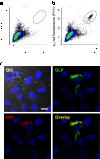Co-localisation and secretion of glucagon-like peptide 1 and peptide YY from primary cultured human L cells
- PMID: 23519462
- PMCID: PMC3648684
- DOI: 10.1007/s00125-013-2887-z
Co-localisation and secretion of glucagon-like peptide 1 and peptide YY from primary cultured human L cells
Abstract
Aims/hypothesis: Targeting the secretion of gut peptides such as glucagon-like peptide 1 (GLP-1) and peptide YY (PYY) is a strategy under development for the treatment of diabetes and obesity, aiming to mimic the beneficial alterations in intestinal physiology that follow gastric bypass surgery. In vitro systems are now well established for studying the mouse enteroendocrine system, but whether these accurately model the human gut remains unclear. The aim of this study was to establish and characterise human primary intestinal cultures as a model for assessing GLP-1 and PYY secretion in vitro.
Methods: Fresh surgical biopsies of human colon were digested with collagenase to generate primary cultures from which GLP-1 and PYY secretion were assayed in response to test stimuli. GLP-1 and PYY co-localisation were assessed by flow cytometry and immunofluorescence microscopy.
Results: GLP-1 and PYY were found localised in the same cells and the same secretory vesicles in human colonic tissue samples. GLP-1 release was increased to 2.6-fold the control value by forskolin + isobutylmethylxanthine (10 μmol/l each), 2.8-fold by phorbol myristate acetate (1 μmol/l) and 1.4-fold by linoleic acid (100 μmol/l). PYY release was increased to 2.0-, 1.8- and 1.3-fold by the same stimuli, respectively. Agonists of G-protein-coupled receptor (GPR)40/120 and G-protein-coupled bile acid receptor 1 (GPBAR1) each increased GLP-1 release to 1.5-fold, but a GPR119 agonist did not significantly stimulate secretion.
Conclusions/interpretation: Primary human colonic cultures provide an in vitro model for interrogating the human enteroendocrine system, and co-secrete GLP-1 and PYY. We found no evidence of PYY-specific cells not producing GLP-1. GLP-1 secretion was enhanced by small molecule agonists of GPR40/120 and GPBAR1.
Figures


References
Publication types
MeSH terms
Substances
Grants and funding
LinkOut - more resources
Full Text Sources
Other Literature Sources

